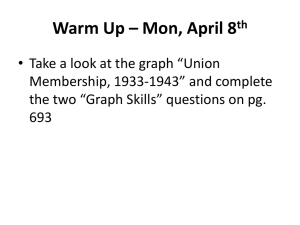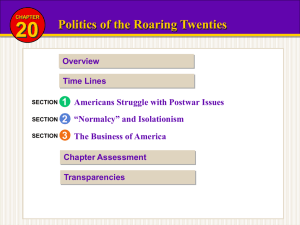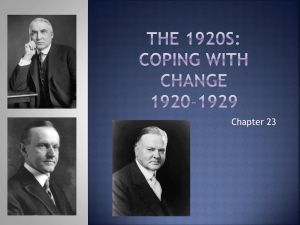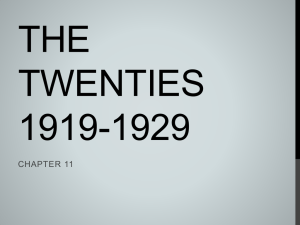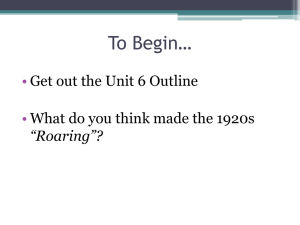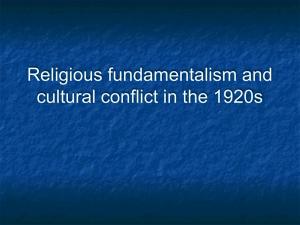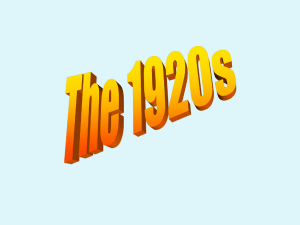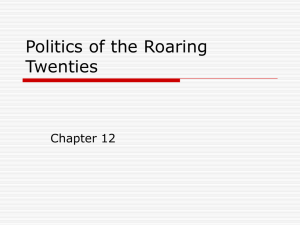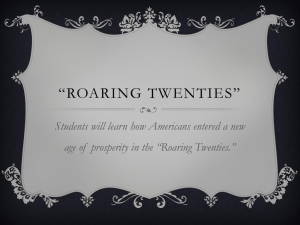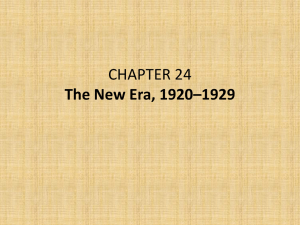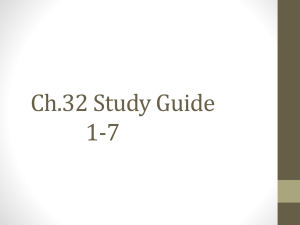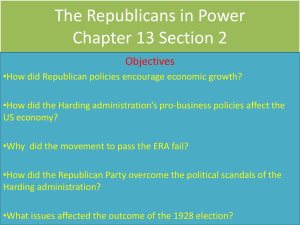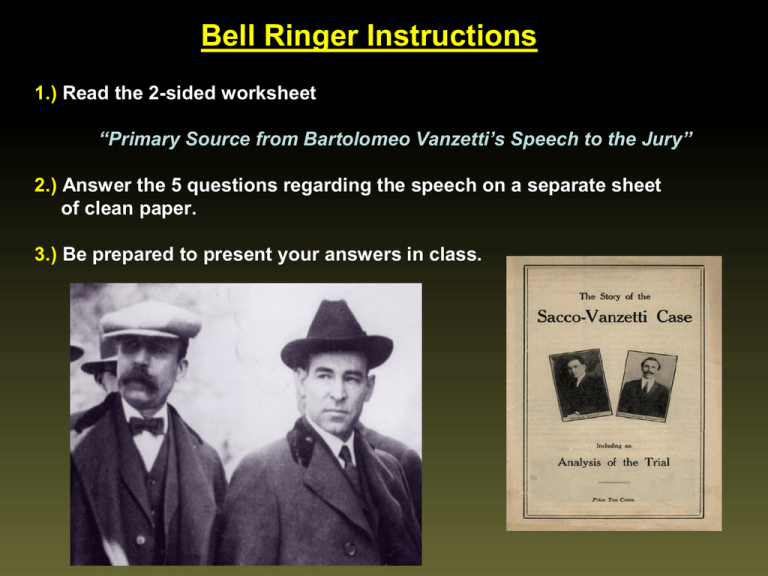
Bell Ringer Instructions
1.) Read the 2-sided worksheet
“Primary Source from Bartolomeo Vanzetti’s Speech to the Jury”
2.) Answer the 5 questions regarding the speech on a separate sheet
of clean paper.
3.) Be prepared to present your answers in class.
Unit 9.1 Notes:
Politics in the Roaring 20s
(Indicators USHC-6.1 & 6.2)
U.S. History & The Constitution
Today’s Lesson Standard / Indicator
Standard USHC-6: The student will demonstrate an understanding of the
conflict between traditionalism & progressivism in the 1920s & the economic
collapse & the political response to the economic crisis in the 1930s.
USHC-6.1: Explain the impact of the changes in the 1920s on the economy,
society, & culture, including the expansion of mass production techniques, the
invention of new home appliances, the introduction of the installment plan, the
role of transportation in changing urban life, the effect of radio & movies in
creating a national mass culture, & the cultural changes exemplified by the
Harlem Renaissance.
USHC-6.2: Explain the causes & effects
of the social change & conflict between
traditional and modern culture that took
place during the 1920s, including the
role of women, the “Red Scare”, the
resurgence of the Ku Klux Klan,
immigration quotas, Prohibition, &
the Scopes trial.
20.1: Americans Struggle with Postwar Issues
- 1920s: thought of as a care-free boom time.
- Reality: American society was divided by the trauma of change.
- Not everyone experienced prosperity.
- Social changes - result of industrialization, immigration & urbanization.
- By 1920, over ½ of the American population lived in cities.
- Increased emphasis on science
& the experiences of the war years
contributed to social change.
- Result - social conflict between
traditional American conservatism &
modern scientific liberalism.
20.1: Americans Struggle with Postwar Issues
- Propaganda of ‘100% Americanism’ during the war years exacerbated
traditional American nativism & turned it into xenophobia.
- Postwar high inflation, competition
from returning veterans & end of wartime
concessions to workers led to labor unrest.
- Labor strikes & the growing socialist
movement in Europe raised American
fears.
- Anarchist exploded eight bombs in
American cities in 1919.
- Fear caused by workers’ strikes,
bolshevism, & bombs led to a Red Scare.
20.1: Americans Struggle with Postwar Issues
- U.S. Attorney General, A. Mitchell Palmer, hoped to gain public support
for a bid for the presidency in 1920.
- Led a series of raids (Palmer Raids)
- Federal government under the direction of J. Edgar Hoover
arrested 4,000 alleged communists & held without bond.
- 600 were deported.
- Palmer predicted a series of anarchist attacks that did not take place.
- He was discredited, but not before arousing feeling against
dangerous foreigners.
20.1: Americans Struggle with Postwar Issues
- New “nativism” = furthered by the trial of Italian immigrants Sacco & Vanzetti.
- Both were avowed anarchists - accused of robbing an armored car & killing a
guard.
- Case became a cause celebre among liberals & civil rights advocates, who
claimed they were being prosecuted for their immigrant status & radical views.
- Prosecution clearly hadn’t made a
case against them, but they were
convicted & executed.
- Evidence indicates that they were
most likely guilty.
20.1: Americans Struggle with Postwar Issues
- Anti-immigrant sentiment - part of rationale for a resurgence of the Ku Klux
Klan (1920s).
- “The Birth of a Nation” (1915 movie) aroused
racist sentiments against African Americans.
- Red Scare & the Sacco & Vanzetti case added
radicals, immigrants & Catholics to the list of groups
targeted by the new Klan.
- KKK used advertising & business organization
to promote membership.
- Became a national organization with a strong
following in small towns & cities of the Midwest
& the South.
- Saw themselves as a moral regulators; Klansmen
targeted bootleggers & gamblers with cross burnings,
public beatings, & lynchings.
- Klan leaders Involved in sex scandals & corruption undermined these
claims to moral leadership & the Klan faded from public view.
20.1: Americans Struggle with Postwar Issues
- Anti-immigrant sentiment turned to xenophobia; resulted in passage of
immigration quotas in the National Origins Act of 1924.
- This had been a goal of conservatives since the end of the 19th century & was
supported by Social Darwinism & Anglo Saxon superiority.
- Immigration from Eastern & Southern Europe
was severely limited.
- Asians were barred entirely.
- This was a limitations on immigration from
Asia of the 19th century [Chinese Exclusion
Act of 1882].
End of 20.1 Notes
20.2: The Harding Presidency
Presidential Candidate Warren G. Harding campaigned in the 1920 election
under his slogan of “A Return to Normalcy.”
- What do you think Harding was trying to emphasize in his slogan?
- Think about the events that led up to the 1920s.
20.2: The Harding Presidency
- Presidential Candidate Warren G. Harding campaigned in the 1920 election
under his slogan of “A Return to Normalcy.”
- Post-WWI, problems = arms control, war debts, & the reconstruction of wartorn countries.
- 1921: Pres. Harding invited several major powers (not Russia) to the
Washington Naval Conference.
- Conference: 5 major naval
powers - U.S., Great Britain, Japan,
France, & Italy - agreed to scrap
many of their warships.
- 1928: 15 countries signed the
Kellogg-Briand Pact, = renounced
war as a national policy.
- Pact was futile (no means of
enforcement).
20.2: The Harding Presidency
- Conflicts arose when it was time for Britain & France to pay back $10 billion
borrowed from the U.S.
- Could do it two ways: 1.) selling goods to the U.S., or 2.) collecting
reparations from Germany.
- 1922: America adopted the Fordney-McCumber Tariff = raised taxes on U.S.
imports to 60% (highest level ever).
- Tax protected U.S. businesses
from foreign competition, but made
it impossible for Britain & France to
sell enough goods in the U.S. to
repay debts.
20.2: The Harding Presidency
- Pres Harding’s cabinet included the “Ohio Gang” (poker-playing cronies).
- Caused embarrassment for Harding’s administration = corrupt & used their
offices to become wealthy through graft.
Teapot Dome Scandal:
- Gov’t set aside oil-rich public lands at Teapot Dome, WY, & Elk Hills, CA, for
use by the U.S. Navy.
- Sec. of the Interior Albert B. Fall had
oil reserves transferred from the Navy to
the Interior Department.
- Fall secretly leased the land to 2 private
oil companies = more than $400,000 in
“loans, bonds, & cash.”
- Hall = found guilty of bribery.
- 1st American to be convicted
of a felony while holding a cabinet
post.
20.2: The Harding Presidency
- Summer of 1923, Harding declared,
“I have no trouble with my enemies. . . . But my . . . friends, they’re the ones
that keep me walking the floor nights!”
- August 1923: he died suddenly, probably from a heart attack or stroke.
- Vice-President Calvin Coolidge then assumed the presidency.
End of 20.2 Notes
- The class is divided into two teams.
- Mr. Weathers will direct a question to one team at a time.
- Every student on the team who think they know the answer (or wants to bluff)
stands up.
- The number of students standing will determine the point value of the
questions (1 student = 1 pt, 4 students = 4 pts. etc.).
- A member of the opposing team selects someone to answer the question that
they think will not know the answer.
- If the person answers correctly, then their team gets the points. If they are
incorrect, the points are given to the opposing team.
- If nobody stands to answer the question, then the question is “given”
to the opposing team for a chance to answer (for free points).
- You cannot call on the same person twice in a row (he/she has
“immunity” for one turn)
Daily “Bell Ringer” Warm Up
3rd Nine Weeks
Bell Ringer #6 (25 & 26 Feb)
6.) Which of the following best describes the position that the United States
took in regards to World (& European) affairs following WWI?
a.) imperialism
b.) expansionist
c.) isolationism
d.) interventionist
CORRECT ANSWER: C
Today’s Lesson Standard / Indicator
Standard USHC-6: The student will demonstrate an understanding of the
conflict between traditionalism & progressivism in the 1920s & the economic
collapse & the political response to the economic crisis in the 1930s.
USHC-6.1: Explain the impact of the changes in the 1920s on the economy,
society, & culture, including the expansion of mass production techniques, the
invention of new home appliances, the introduction of the installment plan, the
role of transportation in changing urban life, the effect of radio & movies in
creating a national mass culture, & the cultural changes exemplified by the
Harlem Renaissance.
20.3: The Business of America
- Economic growth = positive & negative consequences for society.
- Expansion of economic opportunity in the 1920s did not extend to all
Americans.
- Economic boom of the 1920s had negative consequences for some segments
of the economy.
20.3: The Business of America
- End of the 1920s, electric energy fueled most of American industry = brought
economic hardship to the coal industry.
- Mass production techniques = assembly line, introduced by Henry Ford in
1913, brought radios, refrigerators, & many other new products to the
marketplace, but also further marginalized the skilled worker.
- Techniques of efficiency practiced in the 1920s furthered the loss of
individuality for the worker.
20.3: The Business of America
- Workers were underpaid
- Labor unions were unable to protect members because of the Republican
administration’s anti-union attitude.
- Farmers suffered economic depression when the end of WWI brought a loss
of markets & surpluses = low prices & foreclosures
- Led to a widening gap between the ‘haves’ & the ‘have-nots.’
20.3: The Business of America
- Mass media increased bitter “have/have not” differences by advertising the
goods that many could not afford to buy.
- Expansion of consumer financing option(s) of installment buying (plans)
encouraged consumers to change their attitudes about debt.
- ‘Buy now, pay later’ philosophy stimulated the economy; later proved
harmful.
- Availability of new home appliances (washing machine, electric irons &
vacuum cleaners, etc.) led to some social change.
- Women were able to do their households
chores more easily, but led to no
significant change in their position in
society or the economy.
20.3: The Business of America
- The flapper was an icon of the 1920s & her freedom helped to change
attitudes about the role of women, but most women continued the traditional
roles as wife & mother.
- Traditional role was reinforced by advertising.
20.3: The Business of America
- Transportation helped to change urban life.
- Automobiles changed living & dating
patterns for those who could afford to buy
a car.
- Transportation within the cities
led to a further differentiation in
living & working neighborhoods.
- Further divided the urban
community.
- Suburbs grew.
Rise of the Automobile
20.3: The Business of America
- Advent of aviation was exciting & produced cultural icons such as
Charles Lindberg, but had little impact on the average American who
could not afford to fly.
End of 20.3 Notes
20.1 & 20.2 - Roaring 20s Political Cartoon Activity
Directions: you are to work in your small groups to design a political cartoon that
illustrates American views on political & social issues of the 1920s. Your cartoon can be
a critique, or show support, of the social/political issue your group has
chosen.
Topics include:
- Women's suffrage (& liberation – “flappers)
- Nativism
- Red Scare
- Sacco & Vanzetti trial (anarchist, foreigners)
- Racial tension (over northern jobs)
- Economic changes (haves/have not, assembly lines)
- Consumer finance plans (installment plans)
- Prohibition (pro/against)

